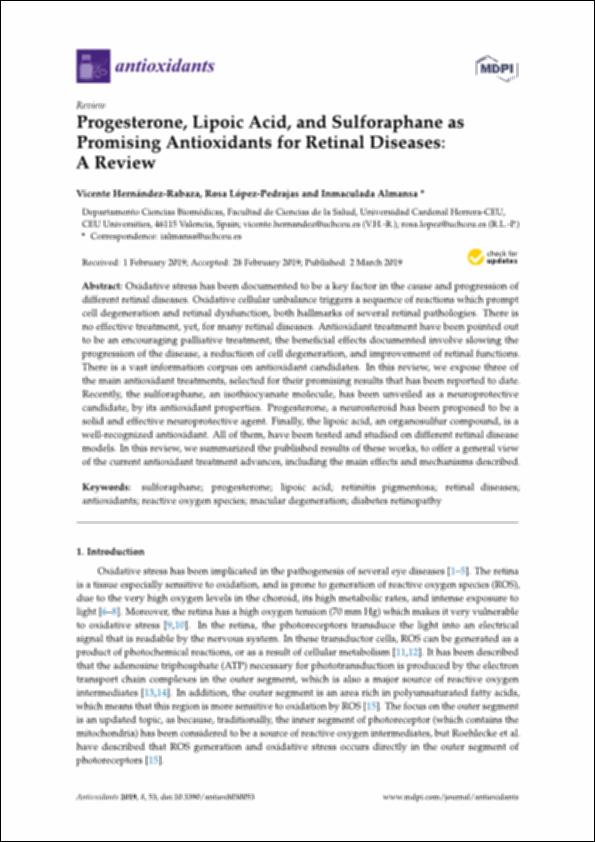Please use this identifier to cite or link to this item:
http://hdl.handle.net/10637/10759Progesterone, Lipoic Acid, and Sulforaphane as promising antioxidants for retinal diseases : a review
| Title: | Progesterone, Lipoic Acid, and Sulforaphane as promising antioxidants for retinal diseases : a review |
| Authors : | Hernández Rabaza, Vicente López Pedrajas, Rosa María Almansa Frías, María Inmaculada |
| Keywords: | Retina - Enfermedades - Factores de riesgo.; Retina - Diseases - Risk factors.; Antioxidantes.; Antioxidants.; Progesterona - Uso terapéutico.; Ácido lipoico - Uso terapéutico.; Sulforafano - Uso terapéutico.; Retina - Diseases - Treatment.; Sulforaphane - Therapeutic use.; Retina - Enfermedades - Tratamiento.; Progesterone - Therapeutic use.; Lipoic acid - Therapeutic use. |
| Publisher: | MDPI |
| Citation: | Hernández-Rabaza, V., López-Pedrajas, R. & Almansa, I. (2019). Progesterone, Lipoic Acid, and Sulforaphane as promising antioxidants for retinal diseases : a review. Antioxidants, vol. 8, n. 3 (2 mar.), art. 53. DOI: https://doi.org/10.3390/antiox8030053 |
| Abstract: | Oxidative stress has been documented to be a key factor in the cause and progression of different retinal diseases. Oxidative cellular unbalance triggers a sequence of reactions which prompt cell degeneration and retinal dysfunction, both hallmarks of several retinal pathologies. There is no effective treatment, yet, for many retinal diseases. Antioxidant treatment have been pointed out to be an encouraging palliative treatment; the beneficial effects documented involve slowing the progression of the disease, a reduction of cell degeneration, and improvement of retinal functions. There is a vast information corpus on antioxidant candidates. In this review, we expose three of the main antioxidant treatments, selected for their promising results that has been reported to date. Recently, the sulforaphane, an isothiocyanate molecule, has been unveiled as a neuroprotective candidate, by its antioxidant properties. Progesterone, a neurosteroid has been proposed to be a solid and effective neuroprotective agent. Finally, the lipoic acid, an organosulfur compound, is a well-recognized antioxidant. All of them, have been tested and studied on different retinal disease models. In this review, we summarized the published results of these works, to offer a general view of the current antioxidant treatment advances, including the main effects and mechanisms described. |
| Description: | Este artículo se ha publicado de forma definitiva en: https://www.mdpi.com/2076-3921/8/3/53 Este artículo pertenece al número especial "Antioxidants and Retinal Disease". |
| URI: | http://hdl.handle.net/10637/10759 |
| Rights : | http://creativecommons.org/licenses/by/4.0/deed.es |
| ISSN: | 2076-3921 (Electrónico) |
| Issue Date: | 2-Mar-2019 |
| Center : | Universidad Cardenal Herrera-CEU |
| Appears in Collections: | Dpto. Ciencias Biomédicas |
Items in DSpace are protected by copyright, with all rights reserved, unless otherwise indicated.


